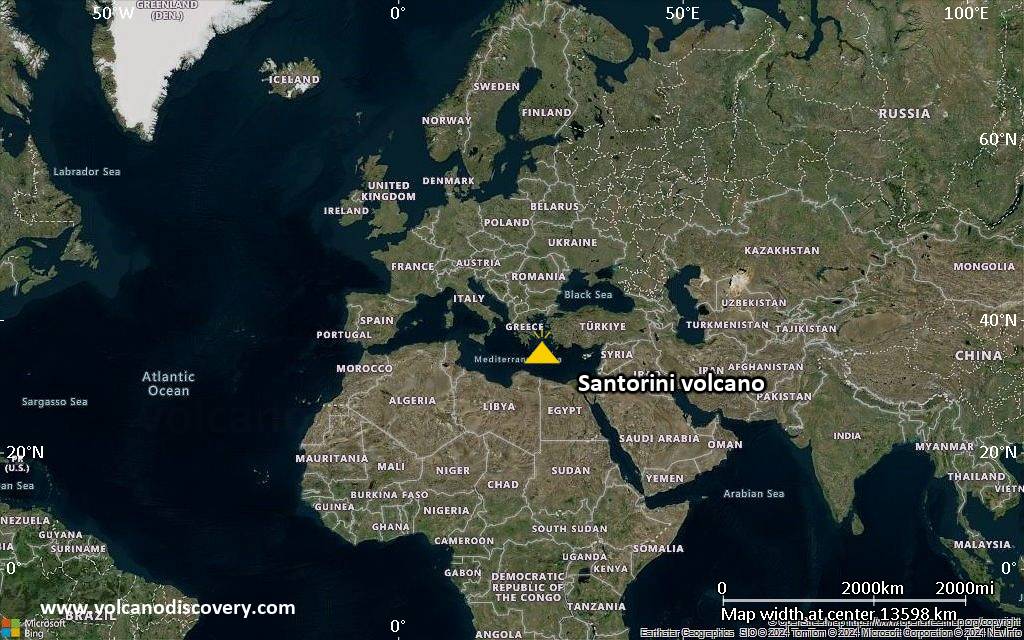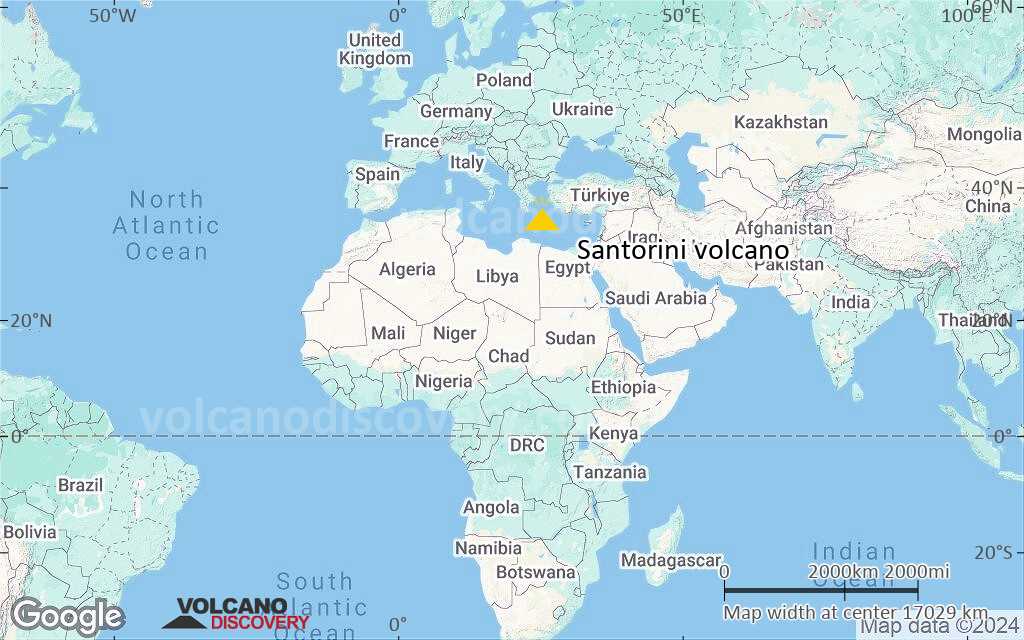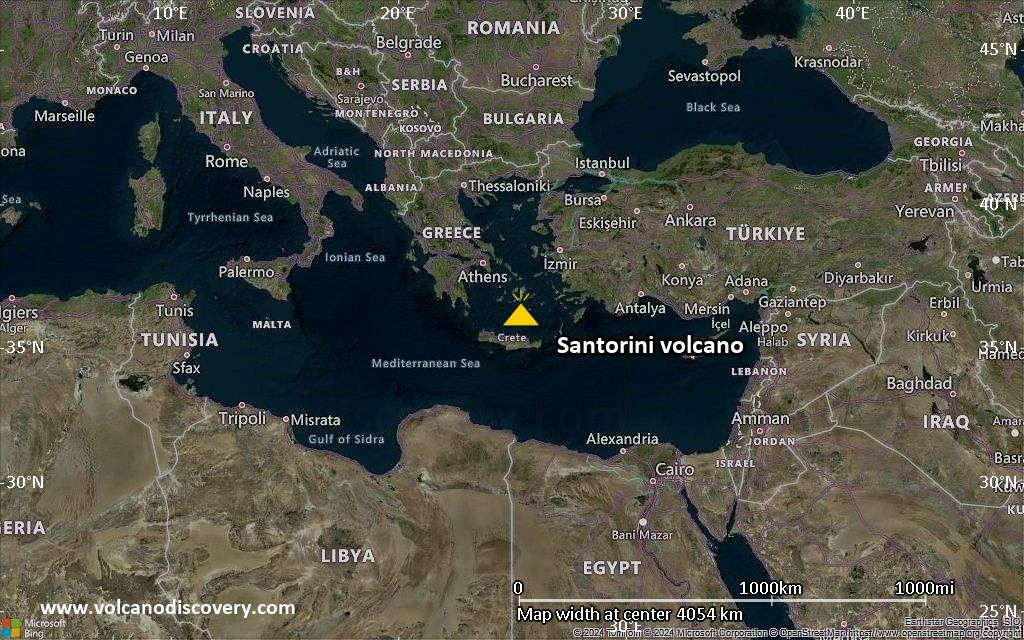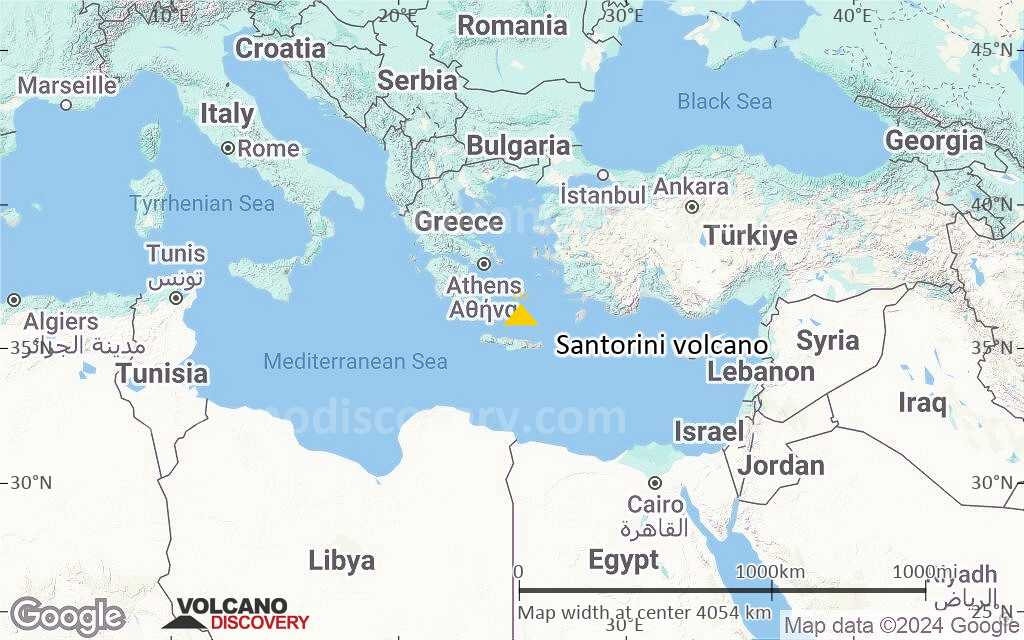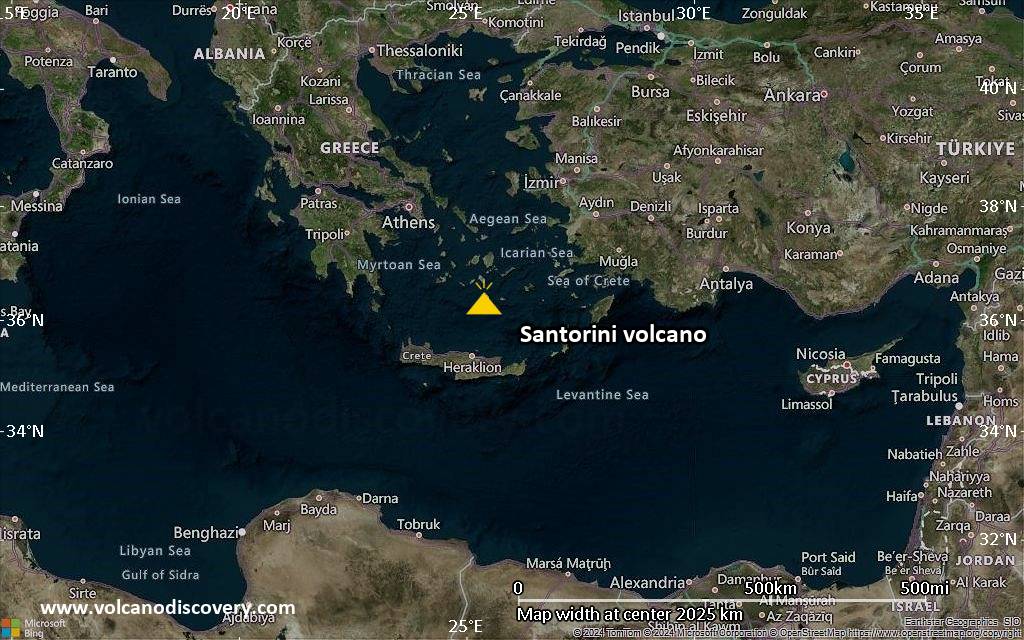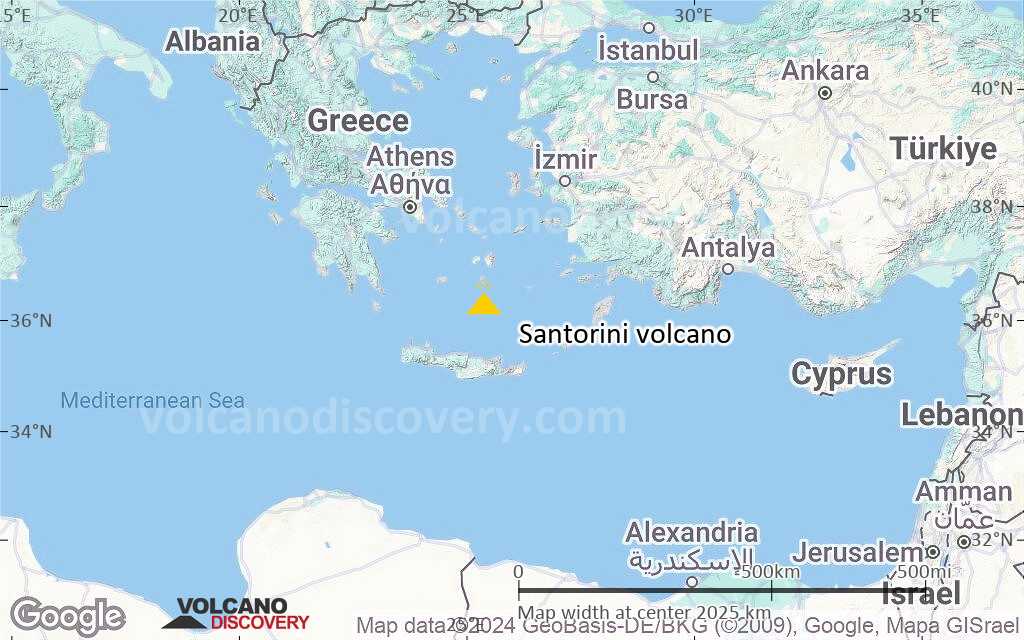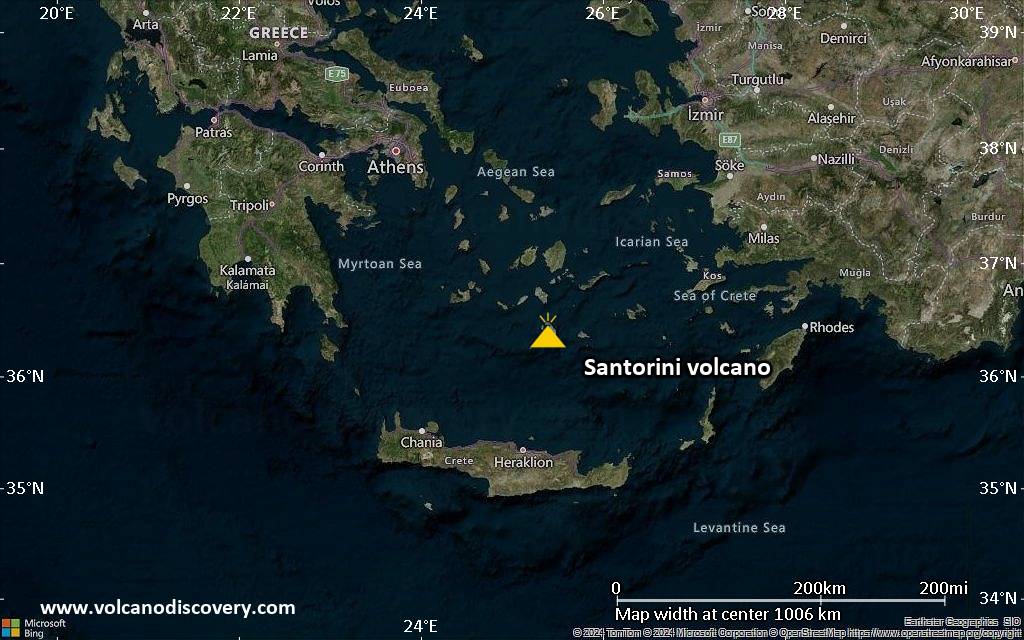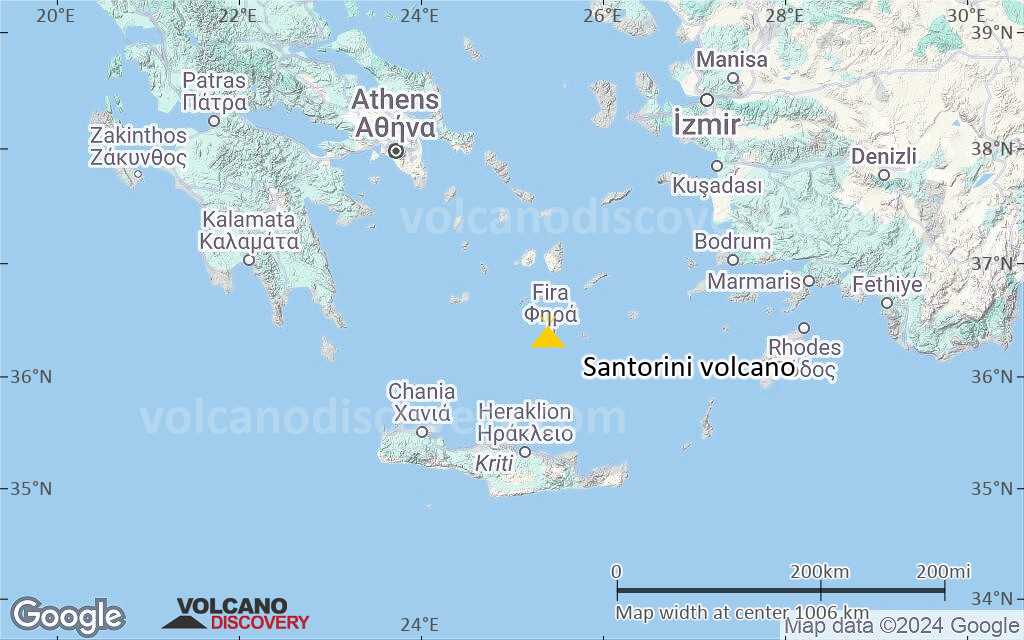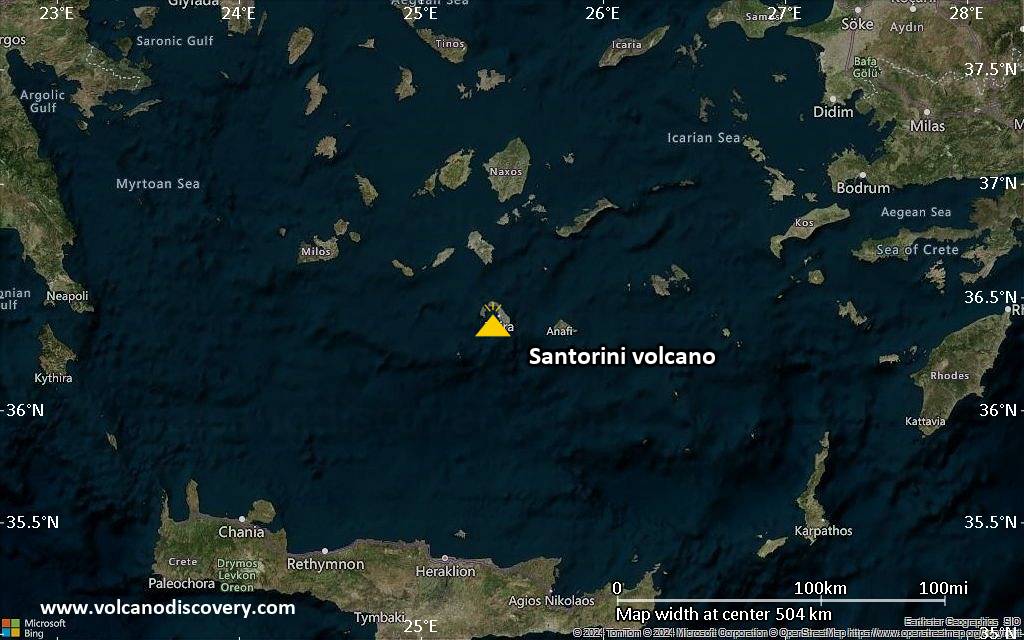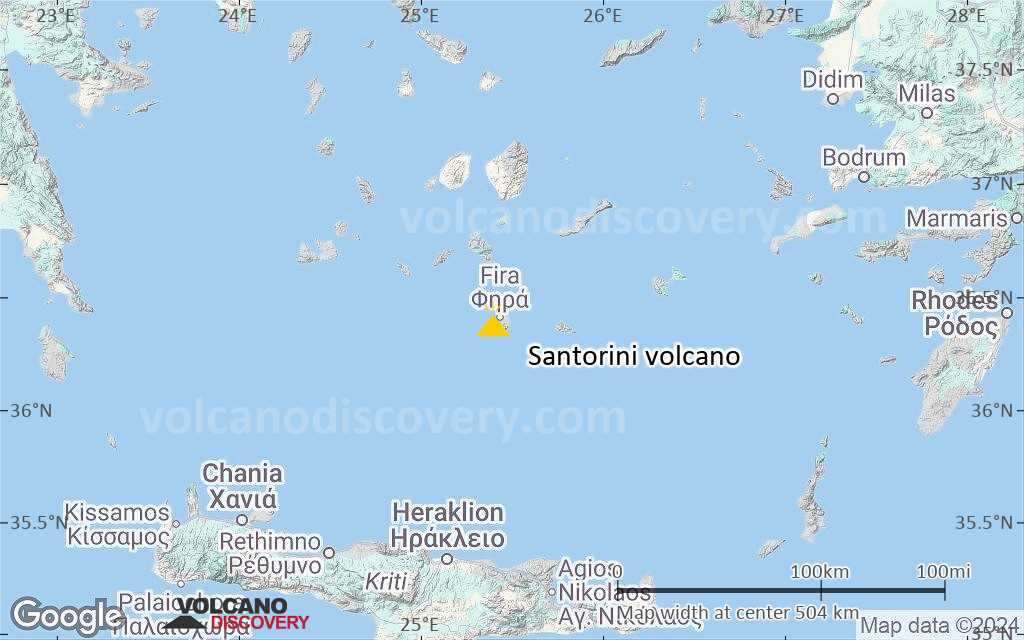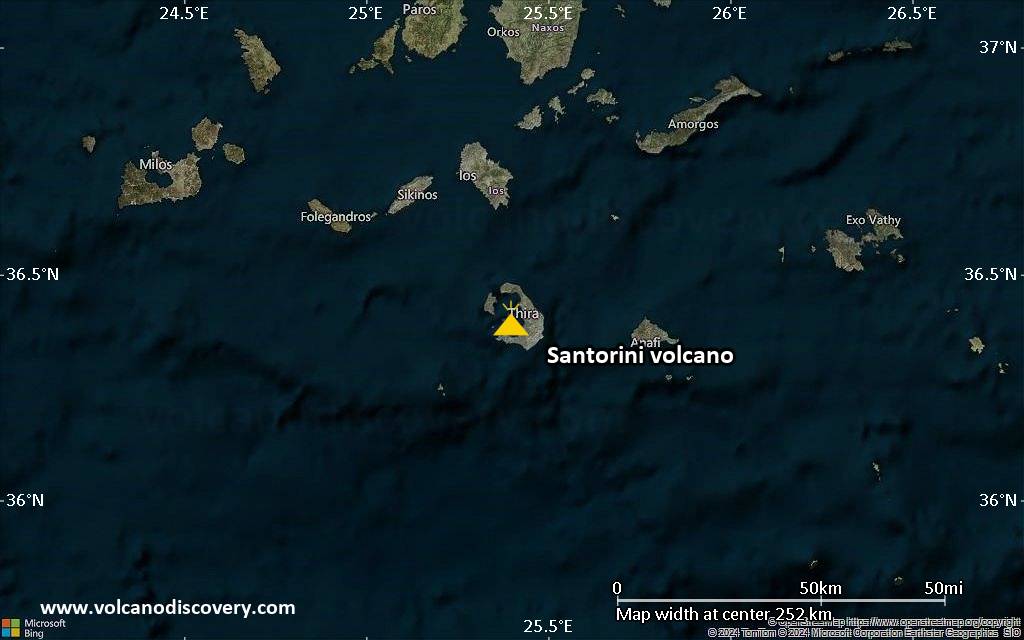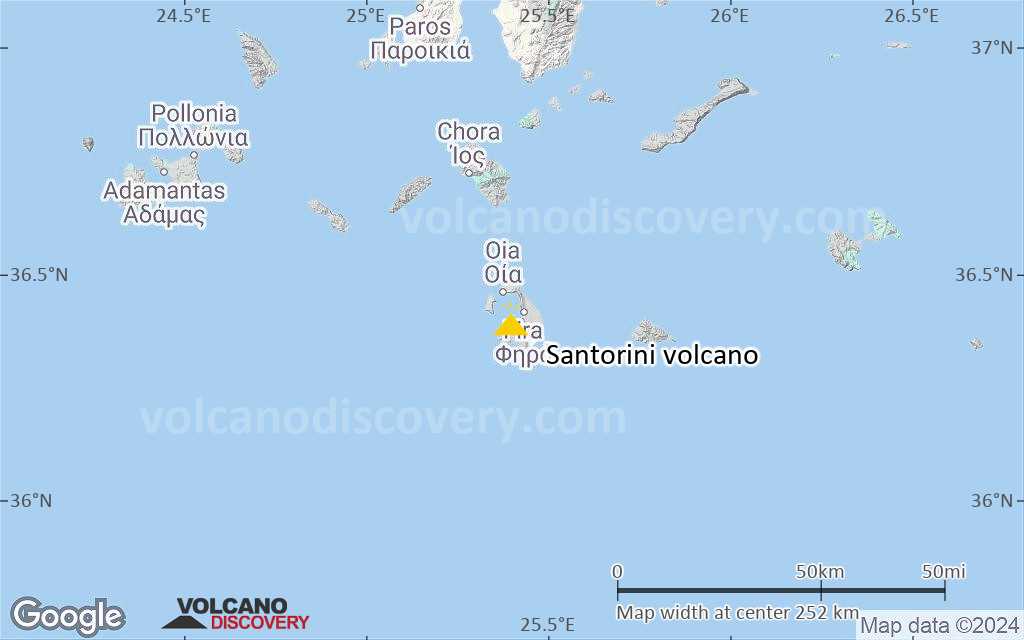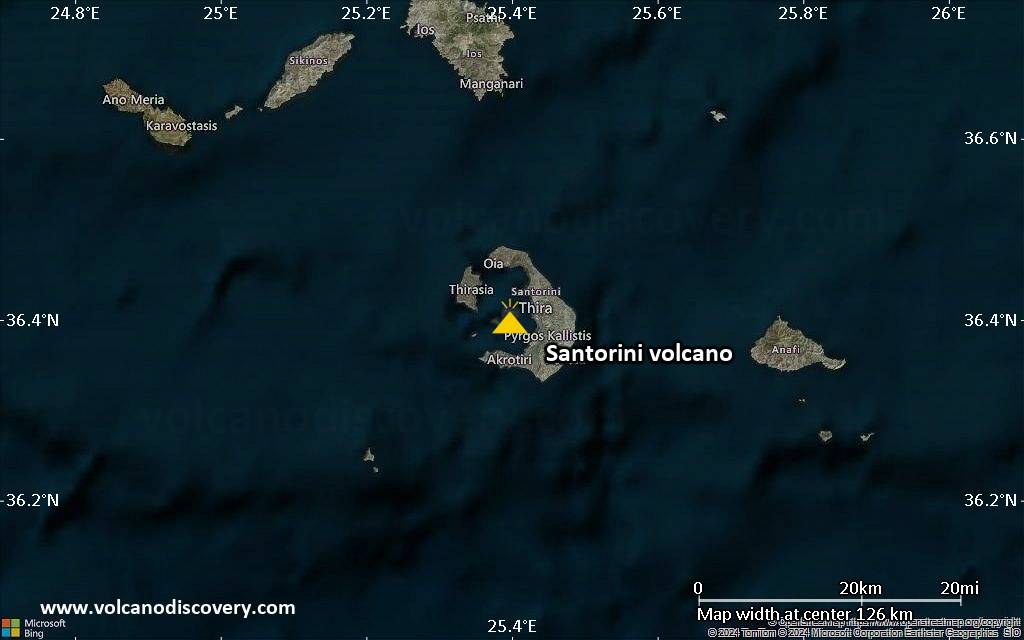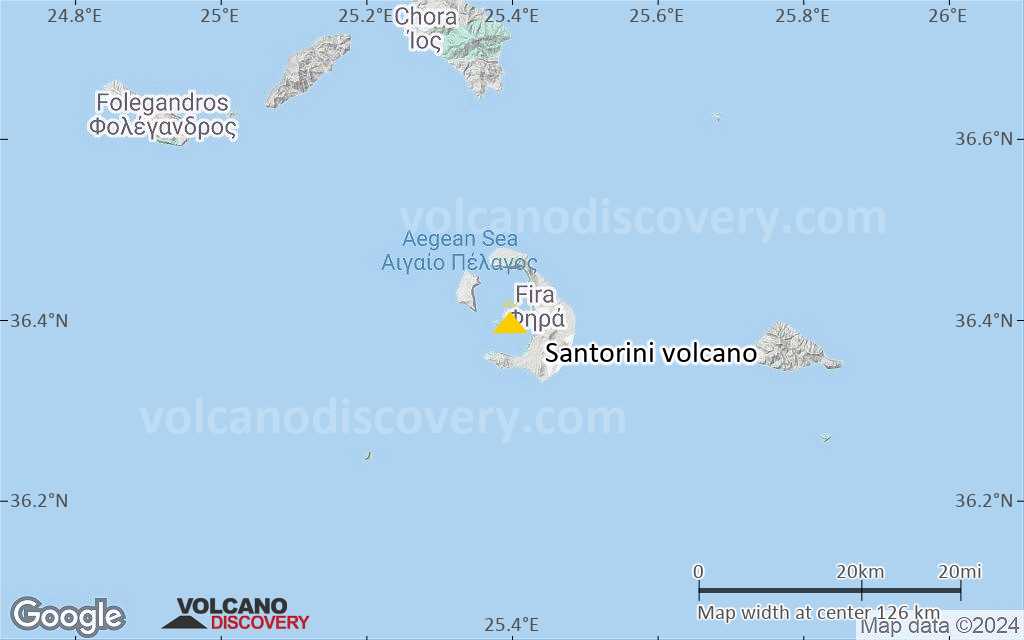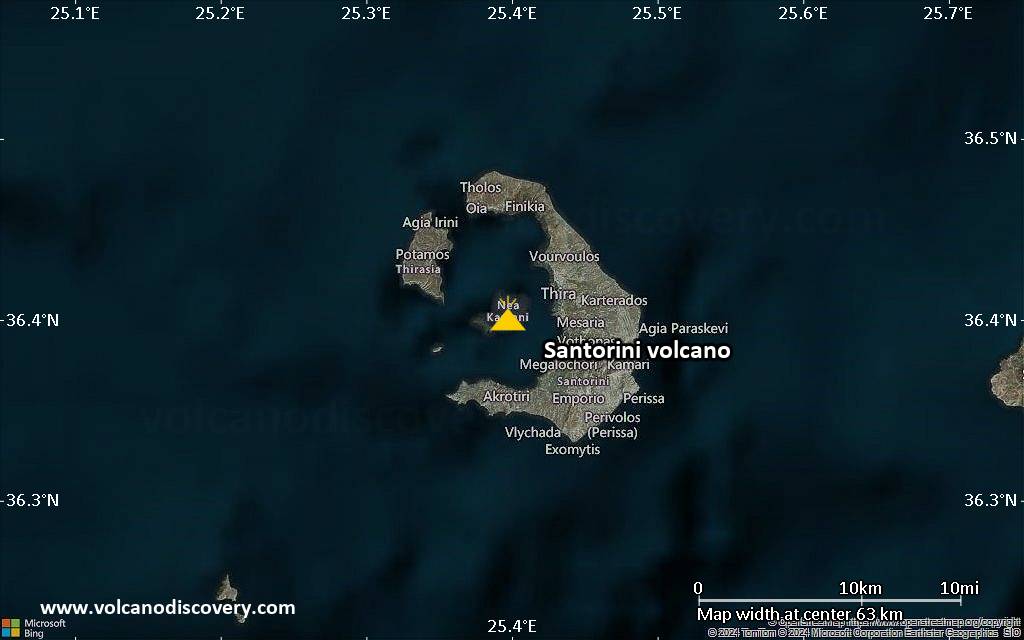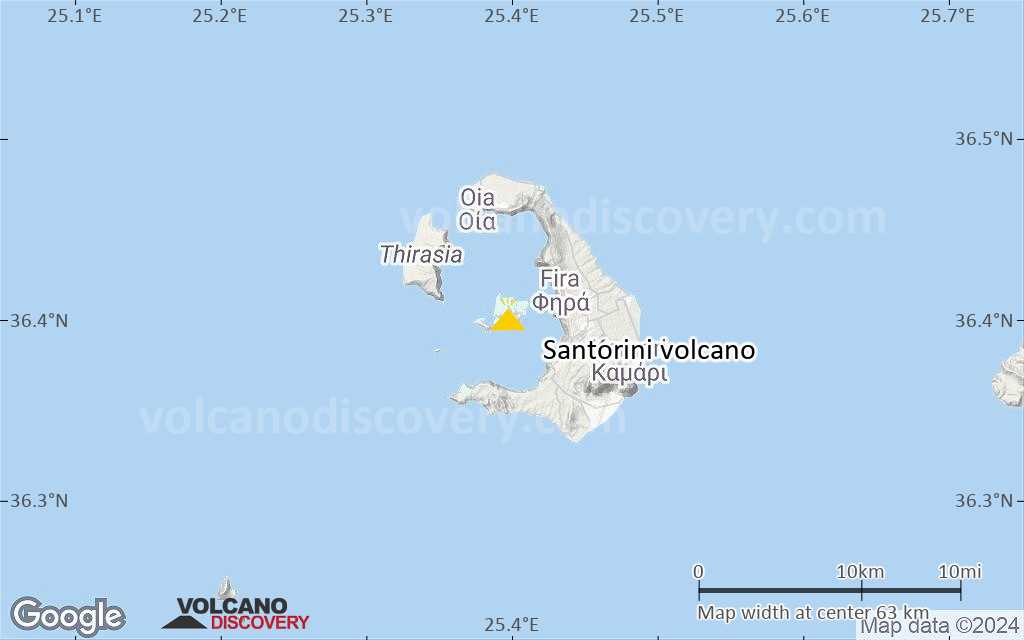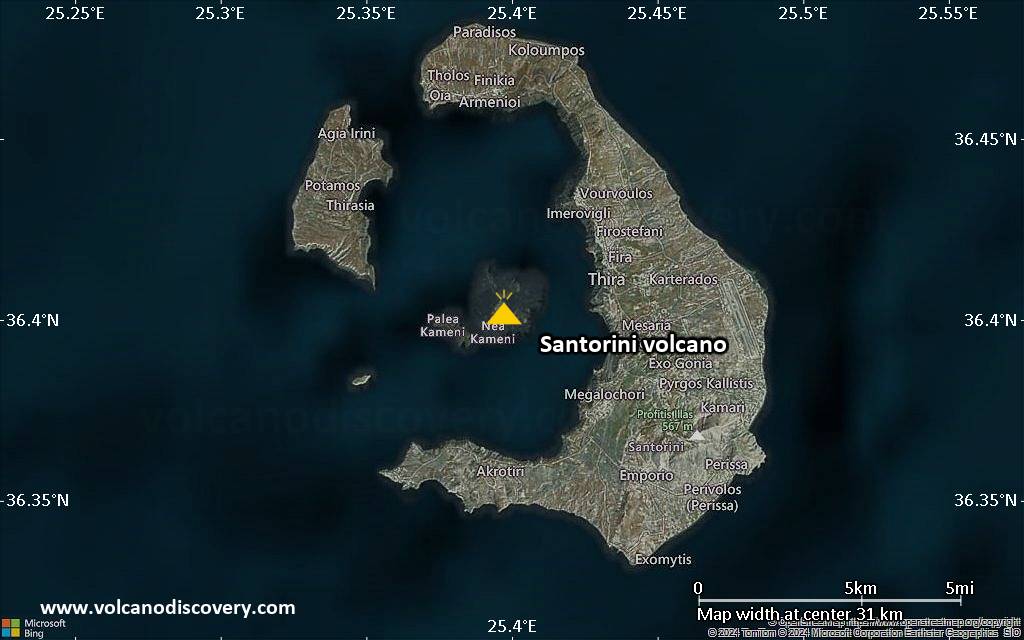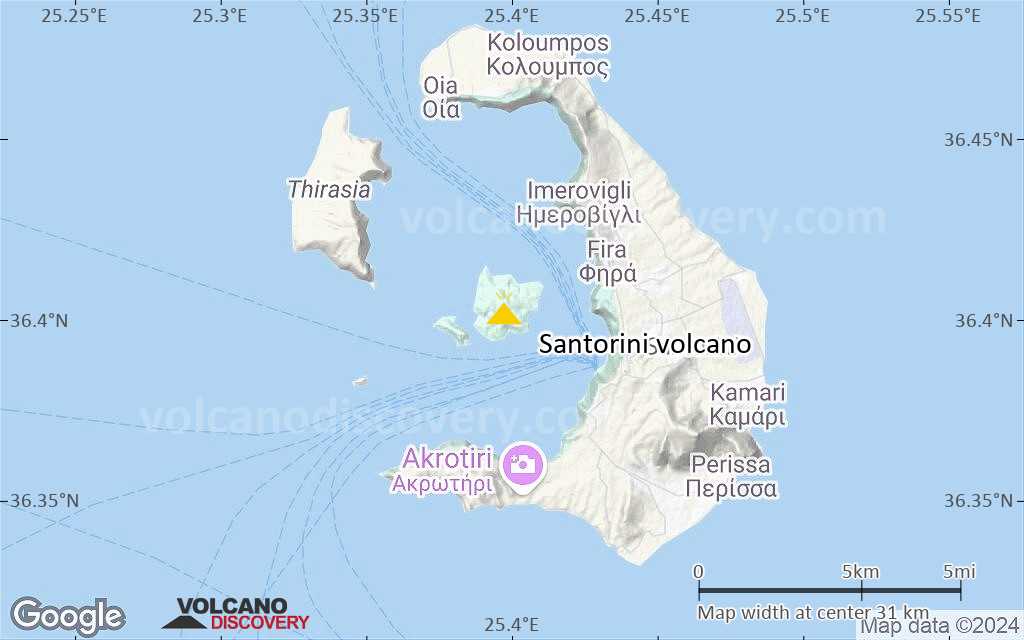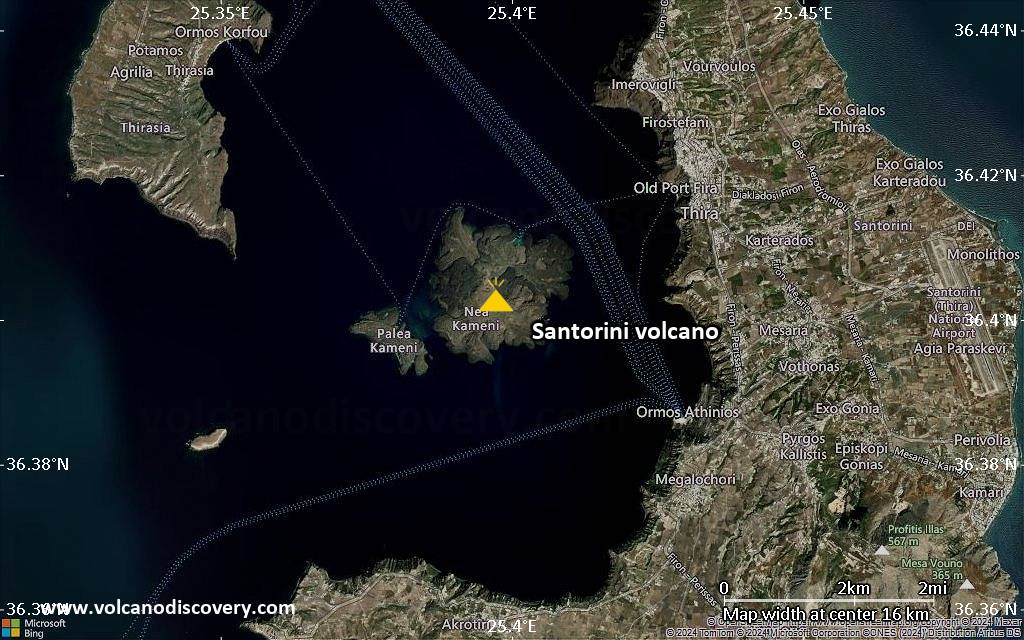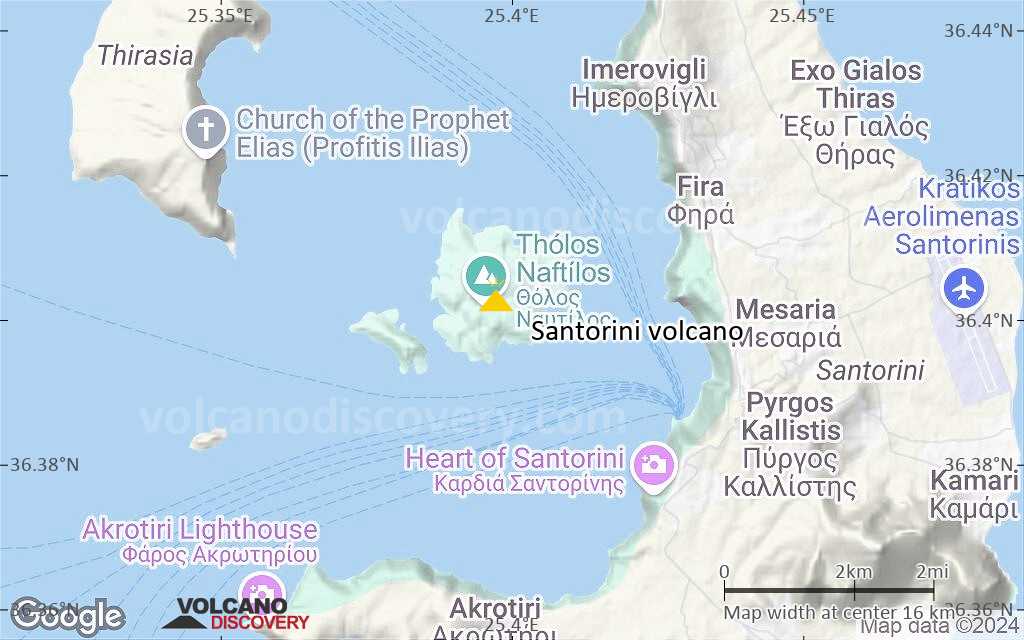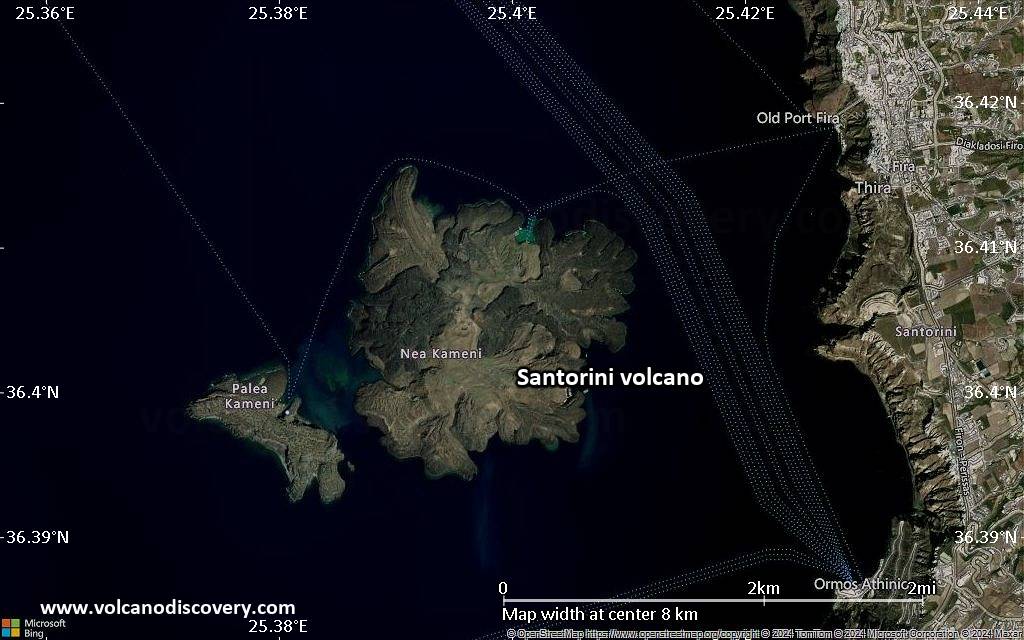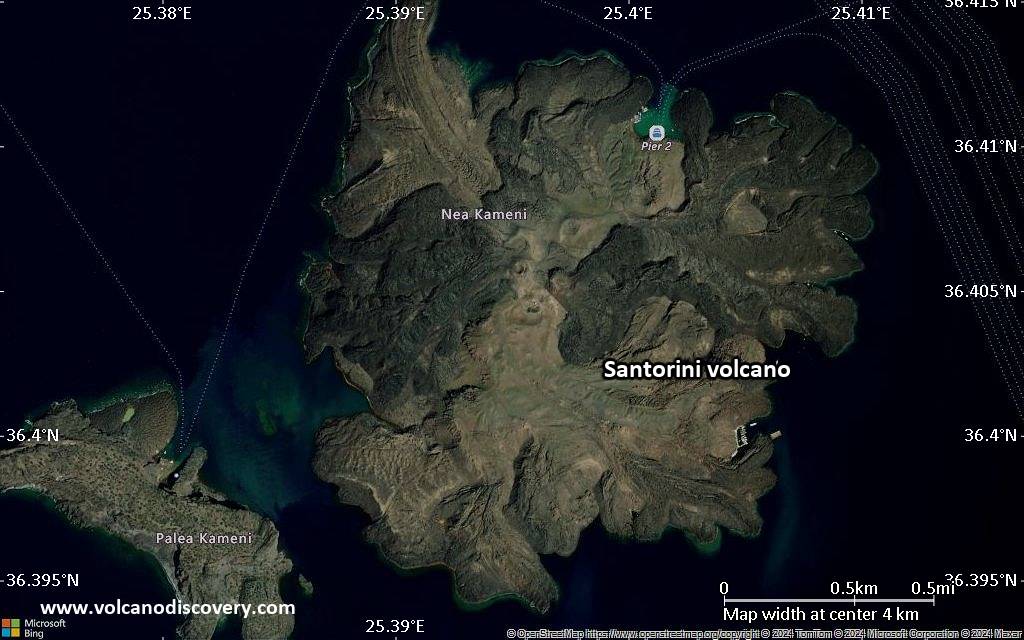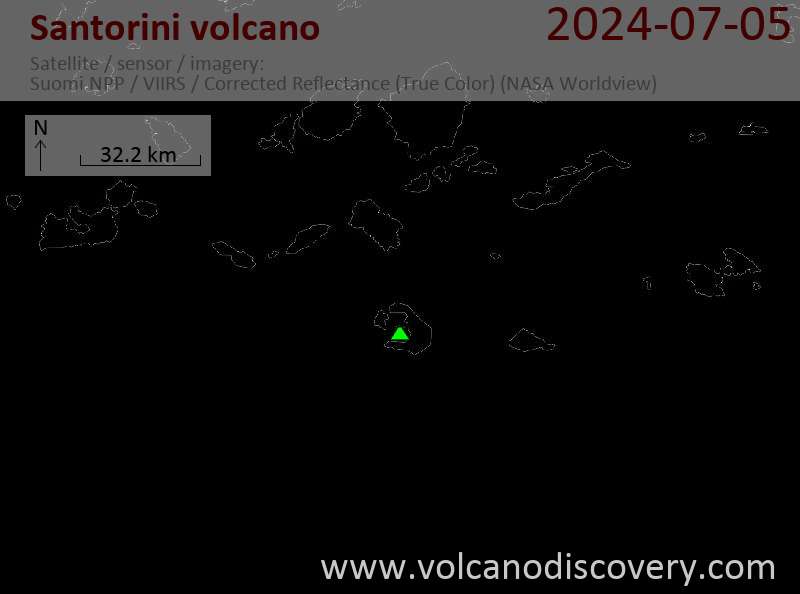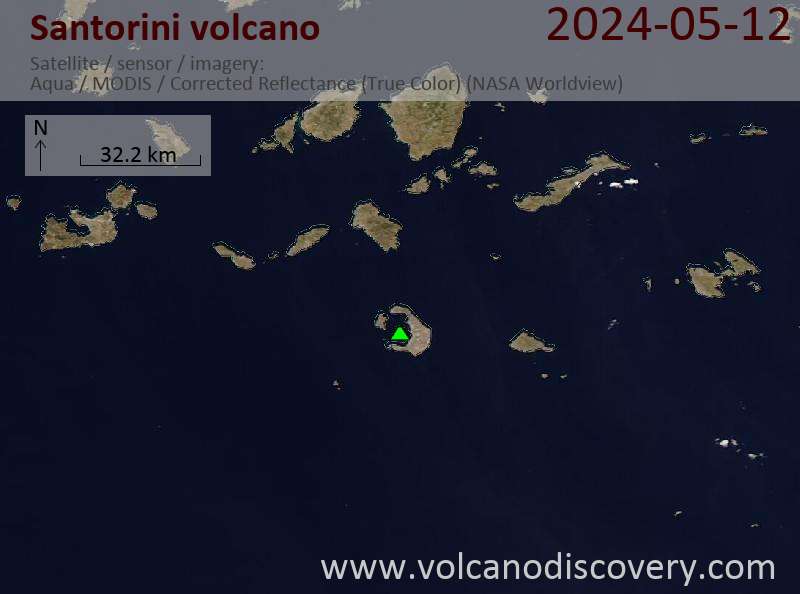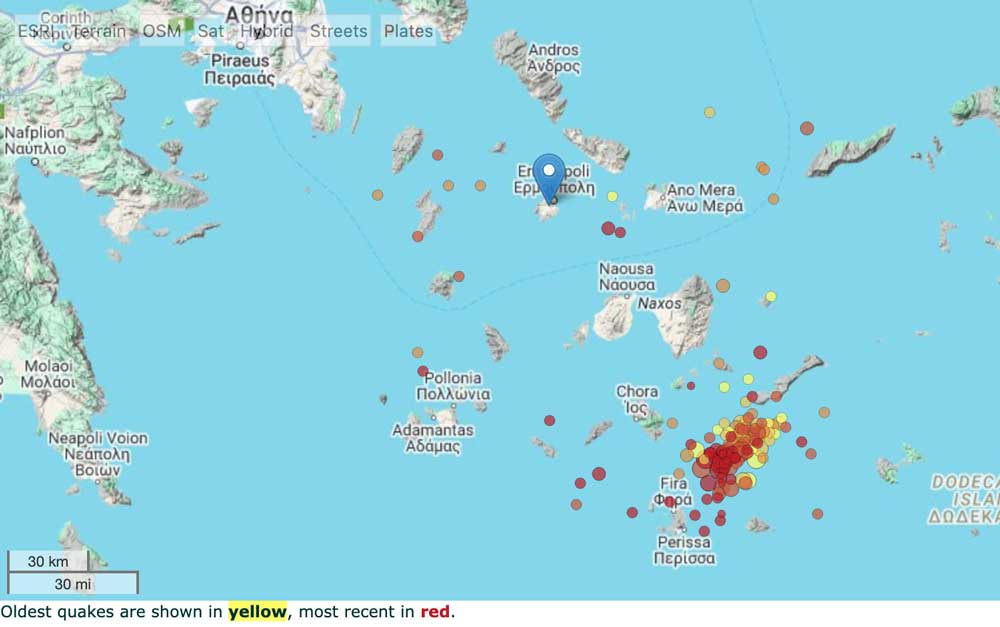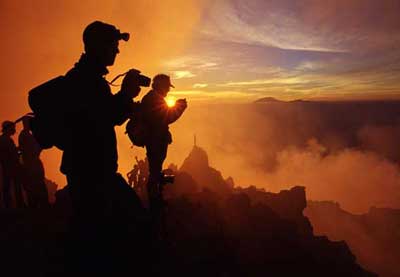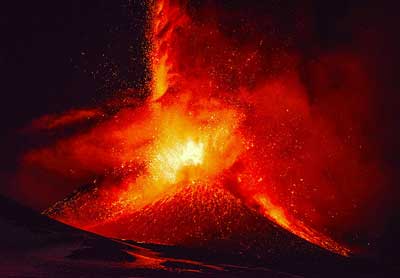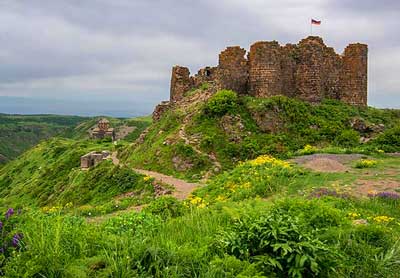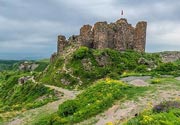Santorin Vulkan
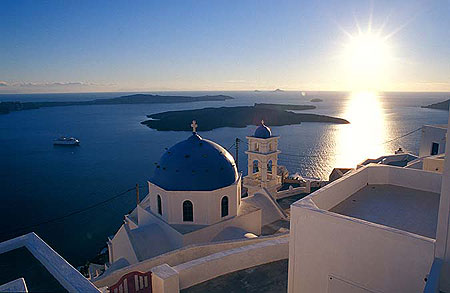
Santorin ist eine vulkanische Inselgruppe am zentralen südlichen Ende der Kykladen im Ägäischen Meer (Griechenland). Als ein beliebtes Reiseziel in Griechenland ist es bekannt für seine spektakuläre vom Meer gefüllte Vulkankaldera.
Ausbrüche des Santorin: 1640 v.Chr. minoische Eruption, 197 v.Chr., 46/47 n.Chr., 726, 1570-1573, 1707-1711, 1866-1870, 1925-1928, 1939-1941, 1950
Letzte Erdbeben in der Nähe
| Datum und Uhrzeit | Mag / Tiefe | Distanz / Ort | |||
|---|---|---|---|---|---|
| 22. Mai. 02:53 (Weltzeit) | 0.4 18 km | 12 km nordöstlich | Info | ||
| 22. Mai. 02:22 (Weltzeit) | 0.9 5.4 km | 23 km nordöstlich | Info | ||
| 22. Mai. 03:45 (GMT +3) | 1.5 6.5 km | 21 km südöstlich | Info | ||
| Mittwoch, 21. Mai 2025 GMT (4 Beben) | |||||
| 21. Mai. 23:34 (Weltzeit) | 0.9 23 km | 25 km nordöstlich | Info | ||
| 21. Mai. 23:24 (Weltzeit) | 0.9 10 km | 25 km nordöstlich | Info | ||
| 22. Mai. 01:54 (GMT +3) | 1.2 6 km | 29 km nordöstlich | Info | ||
| 21. Mai. 22:31 (Weltzeit) | 0.5 14 km | 16 km nordöstlich | Info | ||
| Sonntag, 18. Mai 2025 GMT (1 Beben) | |||||
| 18. Mai. 06:34 (GMT +3) | 2.4 83 km | 11 km nördlich | Info | ||
| Samstag, 17. Mai 2025 GMT (1 Beben) | |||||
| 17. Mai. 09:53 (Weltzeit) | 2.4 9.6 km | 25 km nordöstlich | Info | ||
Beschreibung
Der berühmteste, große Ausbruch auf Santorin ist als der "Minoische Ausbruch" bekannt. Es war einer der größten Vulkanausbrüche der letzten 10000 Jahre auf der Erde. Wie durch neueste Datierungen durch eine dänische Wissenschaftlergruppe aus Kopenhagen sowie eigene Radiokarbondatierungen an der Universität Aarhus bekannt geworden ist, ereignete er sich um das Jahr 1645 v. Chr. (+- 27 Jahre).Die Gesamtmenge an Magma, die bei dem Ausbruch gefördert wurde, betrug etwa 30 Milliarden Kubikmeter, d.h. 30 Kubikkilometer. Gefördert wurde v.a. sehr gasreiches (rhyodazitisches) Magma, das beim Austritt so stark aufschäumte, das fast die gesamte Menge davon als Bims und Asche mit dem dreifachen Volumen ausgeworfen wurde.
Ein großer Teil der feinen Asche wurde dabei in einer gigantischen Eruptionswolke in bis zu geschätzt 36 Kilometern in die Stratosphäre befördert. Der Ausbruch hat durch die Verschmutzung der Stratosphäre durch feinste Aschepartikel und Gase zu globalen Klimaschwankungen geführt. So wurde z.B. auch in Mitteleuropa die Kultur der Bronzezeit in Mitleidenschaft gezogen. Die Zerstörung des Diskus von Nebra ist wahrscheinlich ein Zeichen dafür, dass die Bewohner durch eine Kälte- und Hungerperiode von ihrem Glauben abkamen und das göttliche Symbol der Sonnenscheibe beschädigten und für immer berguben.
Auch in der Region des heutigen Griechenlands muss es zu radikalen kulturellen und religiösen Änderungen gekommen sein. Durch den Ausbruch litt auch das Minoische Reich udn sein Mittelpunkt, die Insel Kreta. Durch Tsunamis und Kälteeinbrüche muss es Hungersnöte und soziale Unruhen gegeben haben. Diese Schwäche nutzten die konkurrierenden Mykener vom Festland Peloponnes und überfielen unter dem mythischen Helden Theseus das Reich des Minotaurus. Gegen 1500 v. Chr. war dann die Zeit der Minoer zu Ende.
Asche und Bimsstein vom Minoischen Ausbruch findet sich noch heute im gesamten östlichen Mittelmeerraum. Sogar im Inlandeis von Grönland ist Asche von Santorin nachzuweisen. Auf Santorin selbt dagegen bedeckt der weiße Bimstein große Teile der Inselgruppe immer noch mit einer stellenweise bis zu bis zu 50 m mächtige Schicht.
Nach der Minoischen Eruption ging vulkanische Aktivität mit geringerer Intensität weiter. Innerhalb der Caldera entstanden so die beiden jungen Vulkinseln Palea und Nea Kameni, die vom Grund des einst ca. 500 m tiefen Beckens emporwuchsen. Der vorläufig letzte, kleinere Ausbruch fand 1950 statt.
Die Aktivität von Santorins Vulkan in geschichtlicher Zeit ist im Großen und Ganzen lückenlos seit der Antike durch Aufzeichnungen und Beobachtungen festgehalten. Damit zählt Santorin zu den am besten dokumentierten aktiven Vulkanen der Welt.
Der antike Historiker Strabo ist einer der ersten Zeugen, die über das Auftauchen einer neuen Insel in der damals noch "leeren" Kaldera berichtet, im Jahre 197 v. Chr. Dabei handelt es sich wahrscheinlich um die heutige Palea Kameni Insel. Es folgten mindestens 9 weitere Ausbruchsphasen: 46/47 v. Chr., 726 n. Chr., 1570-1573, 1707-1711, 1866-1870, 1925-1928, 1938-1941 und zuletzt 1950. Auf den so entstandenen und langsam gewachsenen Inseln Palea und Nea Kameni kann man heute noch die einzelnen Eruptionsphasen anhand von Farbe, Vegetation und Lagerung der einzelnen Lavaströme unterscheiden. Ein Vulkan Santorins, der sich dem Beobachter nicht so leicht erschließt, ist der Kolumbus-Vulkan, der unter dem Meeresspiegel vor dem nordöstlichen Bereich der Inselgruppe Thera in ca. 140 m Tiefe aktiv ist. Zur Zeit gibt es dort Austritte von überhitztem Thermalwasser (in der Art der "black smokers"). Sein letzter Ausbruch fand ca. 1600 n. Chr. statt. Auch er gilt als potentiell gefährlicher Vulkan.
Santorin Volcano Photos
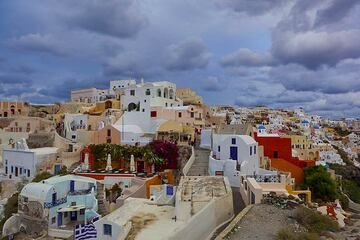
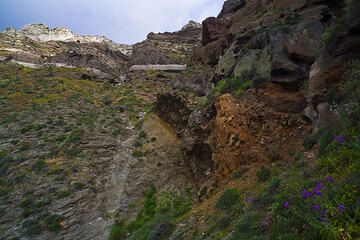
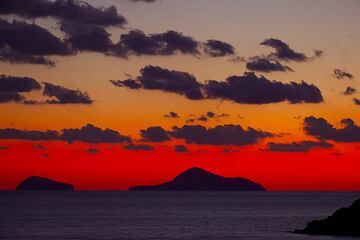
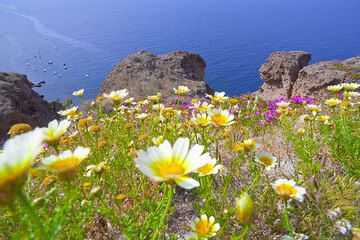
Bedeutende Vulkanausbrüche: Santorin volcano
There is one uncertain or discredited eruption im Jahr 19 AD from Santorin volcano.
| Datum | Hinweis | VEI | Todesopfer | Schaden | ||
|---|---|---|---|---|---|---|
| Nea Kameni (Liatsikas dome) Hist. dokumentiert | 2 | unbekannt | ||||
| Nea Kameni (Triton, Ktenas, Fouque domes) Hist. dokumentiert | 2 | unbekannt | ||||
| Nea Kameni (Naftilos dome) Hist. dokumentiert | 2 | unbekannt | ||||
| 1928 Jan 23 (Ausbruch | Hist. dokumentiert | 2 | 48 | unbekannt | Info | |
| Nea Kameni (Dafni dome) Hist. dokumentiert | 2 | unbekannt | ||||
| Georgios, Afroessa and Reka domes Hist. dokumentiert | 2 | unbekannt | ||||
| 1866 Feb 20 (Ausbruch | Hist. dokumentiert | 2 | 1 | unbekannt | Info | |
| Nea Kameni Hist. dokumentiert | 3 | unbekannt | ||||
| 1707 Mai (Ausbruch | Tsunami aufgezeichnet Hist. dokumentiert | 3 | unbekannt | Info | ||
| Colombo Bank (6.5 km NE of Thera) Hist. dokumentiert | 4? | unbekannt | ||||
| 1650 AD Sep 26 (Ausbruch | Kolumbo volcano 6.5 km NE of Santorini Tsunami aufgezeichnet Hist. dokumentiert | 4 | 120 | leicht | Info | |
| Mikri Kameni Hist. dokumentiert | 3 | unbekannt | ||||
| 1050 AD (Eruptionsepisode | Tsunami aufgezeichnet Hist. dokumentiert | 0 | unbekannt | |||
| NE side of Thia Island Hist. dokumentiert | 4? | unbekannt | ||||
| Thia Island Hist. dokumentiert | 3 | unbekannt | ||||
| 46 AD (Ausbruch | Tsunami aufgezeichnet Hist. dokumentiert | 3 | unbekannt | Info | ||
Diskreditierter Ausbruch | ||||||
| -197 BC (Ausbruch | Tsunami aufgezeichnet Hist. dokumentiert | 3 | unbekannt | Info | ||
| Hiera Island Hist. dokumentiert | 3 | unbekannt | ||||
| -1610 BC (Ausbruch | Tsunami aufgezeichnet Hist. dokumentiert | 7 | 100-1,000 (*) | schwer | Info | |
| Plinian "Minoan" eruption; Central and northern caldera area | 7? | unbekannt | ||||
Ausbrüche des Vulkans Santorin
10. Jan. 1950 - 2. Feb. 1950: Small effusive activity ("Liatsikas" lavas) preceded by phreatic explosions.
More info
20. Aug. 1939 - July 1941 -- Formation of several lava domes ("Tritona", "Ktenas", "Fouqué", "Smith-Reck" and "Niki"). Extrusive and slighly explosive activity. Lava outflow in most cases preceeded by phreatic explosions.
more info
11. Aug. 1925- 17. March 1928 -- Moderate effusive and explosive activity. Growth of Nea Kameni. Lava flows, lava fountains and ash-falls.
- Aug. 1925 -- Rising temperature in the Red bay ("Kokkina Nera", gr. = red waters) at the eastern shore of Nea Kameni and subsidence of Nea Kameni's east shore. Vapor fountains and lava outflow. ...mehr Infos
4. Feb. 1866 - 15. Oct. 1870 -- Moderate effusive and minor explosive activity. Mikri and Nea Kameni unite. Lava flows, lava fountains and ash-falls. ...mehr Infos
No volcanic activity occurred during 1711-1866. Mikri and Nea Kameni were 2 separated islands forming 2 natural bays (Georgios and Vulkano bay). Sulfuric fumaroles in Vulkano bay. Building of a small harbor and ca. 50 summerhouses (!) on Nea Kameni.
23. May 1707 - Sept. 1711 -- Formation of Nea Kameni (gr., = "the new burnt island"). Strong surtseyan and effusive activity. Ash-fall and gas explosions. Lowering of the coastline of Thera and Mikri Kameni. ...mehr Infos
27. Sept 1650 -- Kolumbo submarine volcano (ca. 8 km NE of Cape Kolumbo, Santorini): strong surtseyan-subplinian eruption with ash and pumice fall, toxic gasses (>50 fatalities). Generation of a strong tsunami.
more info on Kolumbo volcano
Formation of Mikri Kameni (gr., = "small burnt island"). Surtseyan activity, ash-fall and block fall-out accompany the formation of a lava dome which rises above sea level to form the new island Mikri Kameni.
Unclear reports from Athanasius Kircher (1665) and Buondelmonte (1465/66) indicate that either a part of Palea Kameni collapsed and disappeared or a new island between Palea Kameni and Thera was built.
Strong explosive probably sub-plinian eruption. Records by Nicephoros (758-823), Theophanes (752-818) and Cedremus (after 1059). Probably small effusive activity following the pumice eruption creating the black blocky lava lobe at Agios Nikolaos (the small harbor bay with the church and hot iron springs).
No reports of activity are known from that period. There was either actually no eruption or it has not been recorded.
Appearance of a new island that probably grew together with Hiera and formed the basis of Palea Kameni. Descriptions by Roman historians Seneca (4 BC-65 AD), Livy (59 BC-AD 17), Pliny the Elder (23-79 AD), Dio Cassius (ca. 200 AD), Aurelius Victor (4th century AD), Philostratos (ca. 200 AD), Orosius (5th century AD), Cassiodorus. (418-562 AD), Labbreus (1670). Probably surtseyan activity with updoming of the sea-floor.
Formation of an island called Hiera (gr., = "the holy one") inside the caldera, probably a precursor of Palea Kameni. Documented by greek and Roman writers: Strabo (66BC - 24 AD), Plutarch (ca. 40-120 AD), Pausanias (ca.120 AD), Justinus (2nd century AD), Eusebius from Cesarea (270-340 AD) and Ammianus Marcellinus (ca. 330-400 AD). Probably surtseyan activity with updoming of the sea-floor (comparable with the 1707-1711 events).
The most recent plinian eruption on Santorini occurred in the late Bronze Age at around 1613 BC and is known as the so-called Minoan eruption. It is one the biggest known volcanic explosions in younger time,- and one of the most studied, but still most mysterious eruptions of all time-. It devastated not only Santorini, but had a deep impact on the whole of the Eastern Mediterranean. Perhaps it even had serious world-wide effects and changed history.
Size of the Minoan eruption
Dating of the Minoan eruption
Still today, one can see its deposits, the characteristic, tens of meters thick layer of white pumice and ash that blankets most of the surface of the island group. The eruption changed the shape of the island itself dramatically: it is now believed that before the eruption, it had the shape of an almost complete ring that enclosed an earlier, shallower caldera.
Large sections of island collapsed into the emptied magma chamber after the eruption, literally disappearing under the sea. The ring-island was breached to the W and NW, and the caldera was significantly widened and deepened.
The Minoan eruption devastated the rich, highly developed economic center, that Santorini was at that time. Since 1969, intense archaeological excavations have brought to light an important Cycladic/Minoan town which had been buried beneath the volcanic ash for almost 4000 years. Although it appears that people had time to evacuate their island in time before the eruption, carrying most of their goods with them, the findings from Akrotiri are impressive: especially, they include well-preserved and magnificent wall paintings, ceramics and other objects. Thanks to the work of numerous archaeologists, a new light was thrown on an important prehistoric period and culture. The spectacular discovery even induced continuing speculations that relate the volcanic destruction of Santorini to the legend of the sunken Atlantis.
Santorin Volcano FAQ
+When was the last eruption of Santorin volcano?
The last confirmed eruption of Santorin occurred im Jahr 1950.
+How often does Santorin volcano erupt?
Since 197 BC, Santorin volcano has had at least 11 historically documented eruptions. This means that it erupts on average every 202 years.
Many eruptions of Santorin have lasted more than one year. In total, the volcano has been in eruption during 26 out of 2222 years until now. In other words, Santorin has been active at least one in 85.5 years on average. Note that this value is likely an underestimate, because the known history of eruptions from Santorin is likely incomplete, especially further back in time.
+How active is Santorin volcano at present?
Santorin volcano is infrequently active: Since 1900, it has had 7 eruptions, and been active during 7 years out of 126 as of now. This means, Santorin has been in eruption one in 18 years on average. The last eruption was in 1950 and ended 75 years ago.
+When was the largest eruption of Santorin volcano?
The largest eruption known from the younger geological history of Santorin volcano occurred ungefähr im Jahr 1610 BC. It ranks as a sub-plinian eruption with a magnitude 4 on the VEI (Volcanic Explosivity Index) scale.
Neueste Satellitenbilder
Preis from 750 EUR
Preis 1890 €
Santorin Vulkan Karten
